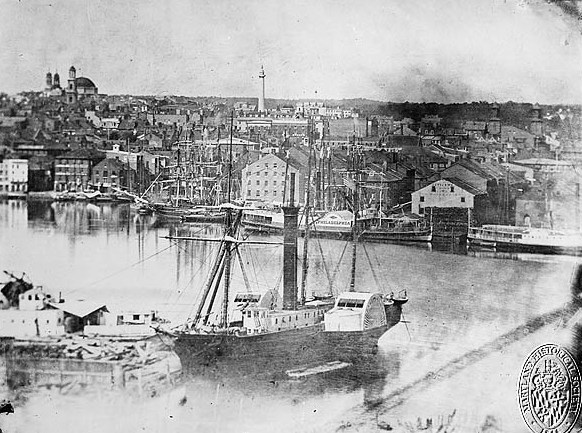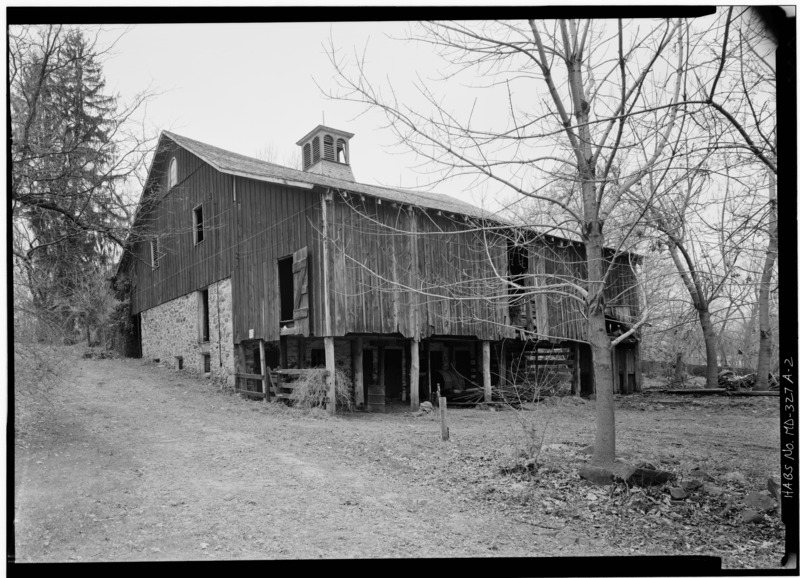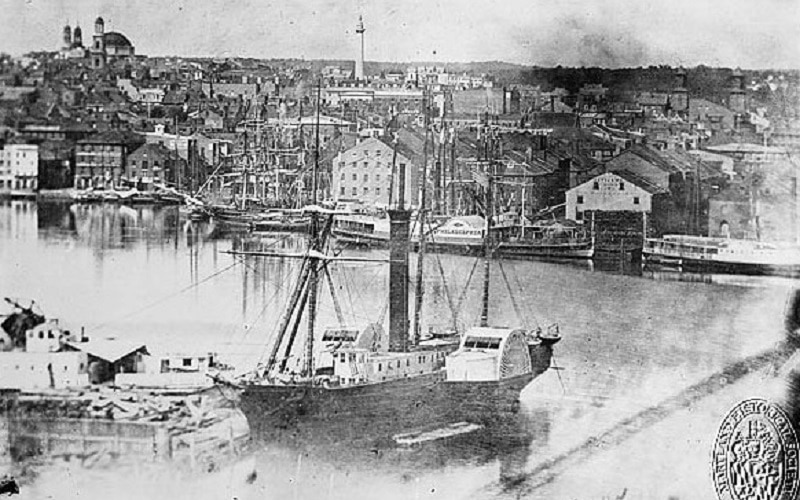The Jeanie Johnston was one of the few famine-era ships that never lost a single passenger or crew member during its transatlantic crossings. Unlike many of the ‘coffin ships’, it had a captain who tried to maintain safe conditions on board by hiring a doctor and providing basic food.
Over 16 journeys, the ship brought around 2,500 passengers to North America. However, because of poor record-keeping and the fact that most emigrants moved away from the ports they landed at, it is difficult to know what happened to them.
However, there is one passenger who seems to have found success after arriving in the US in 1849.
Sailing to Baltimore
Between 1848 and 1855, the Jeanie Johnston’s main route was between county Kerry in the south-west of Ireland and Quebec in Canada. Usually the ship set sail from Tralee twice a year carrying passengers to Quebec, before returning with a hold full of timber.
However, in March 1849, the Jeanie Johnston set sail for Baltimore in the US state of Maryland and returned to county Cork with a cargo of grain. After New York and Boston, Baltimore was the largest port of entry for immigrants to the US. On May 4th, the Jeanie Johnston arrived with around 119 adults and 27 children on board. Their ages ranged from six months to 60 years.

Maryland Center for History and Culture, Public domain, via Wikimedia Commons
Passage to Baltimore cost £4 4 shillings. This was almost a pound more than the journey to Quebec. This is because the US had laws that limited passenger numbers and this pushed fares up. While the Jeanie Johnston offered relatively safe conditions on board, it was known to carry more than 200 passengers.
Price and Restrictions
To put the cost into perspective, in 1845 agricultural labourers in Ireland would have earned up to 3 shillings per week. Even if they had consistent work and saved every penny of their income, it would have taken at least six months for them to afford a ticket.
As a result, the Baltimore passenger list features many passengers with higher paid occupations. As well as 21 labourers, there were farmers, carpenters, cartwrights, clerks, smiths and shoemakers. Most of the women on board were listed as wives or spinsters, but a couple were servants and dressmakers too.
This detailed passenger list may have survived because of the strict US laws and penalties around passenger numbers and provisions. But considering the list features some blank entries, misspellings and a couple of very young spinsters, the accuracy of the information is somewhat questionable.
The fortunes of Patrick Kearney
One of the passengers who took the two month voyage across the Atlantic was a young man around the age of 20 named Patrick Kearney. He is listed as being a gardener. On board, there was a woman named Mary Kearney too. She may have been his wife, but this is probably just a coincidence.
What is known, according to the Kerry County Museum, is that shortly after his arrival in Baltimore, Kearney headed about 25 miles north to Harford County.
At that time, the area was covered in agricultural land dotted with farmhouses, cottages and barns. At its heart was the two-sided main street of Bel Air, which featured some storefronts, a courthouse and a sheriff’s house. The construction of a brewery would have been underway at this time, but no railway line had yet reached the area. There wasn’t even a jailhouse in the town, so rooms in the surrounding region were rented to house prisoners.

Public domain, via Wikimedia Commons.
In August 1850, as part of that year’s census, Kearney is recorded as living on the farm of an American named David Ferris. Ferris’s wife, son, a boy named James Hodges and a young black woman named Rachel Bond also lived there.
Later In Life
Just ten years later, during the census of 1860, Kearney was still living in the same spot but his fortunes were much improved. He was now listed as a farmer living with his wife Mary and five young children – Bridget, Frank, May, Andrew and Micheal.
Though it highlights that Patrick and Mary are unable to read or write. The census assistant also noted that their land was worth an estimated $1,500, while their personal property was worth around $150. Kearney even had a 50-year-old Irish labourer living with his family who, presumably, helped him run the farm.
By 1860, Kearney’s previous employer owned another farm in New Jersey, so it is likely that he sold part of his farm to Kearney before moving there. It’s also interesting to note that many of Kearney’s neighbours were Irish too, while others were from France, Bavaria and Germany.
Though it would appear Kearney found success in the US, his fate in later life remains unclear. In the 1880 census, a married couple with similar details pop up in Philadelphia. This Patrick is listed as a gardener. But another couple with similarly named children, as well as six further children, also lived out their lives in Baltimore.
If you’d like to experience Patrick Kearney’s transatlantic journey for yourself, his story is reimagined through an immersive audio-visual installation at the EPIC Museum. You can also follow his path on board the Jeanie Johnston tall ship. Book a visit today.

